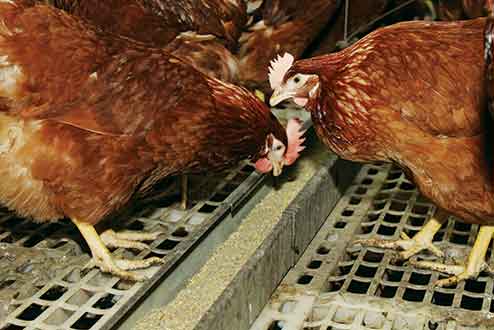Top poultry tips on hen nutrition in cold weather

Getting nutrition right for layers is even more important as outside temperatures plummet.
With cold weather potentially inhibiting the ability of free-range hens to self-regulate their body temperature, egg producers may need to revise their feeding regimes to accommodate the bird’s additional energy requirement.
Within the hen’s “thermoneutral zone” – approximately 20C to 25C – hens are usually able to maintain a constant body temperature with the help of physical heat regulation, says ABNs’ poultry technical specialist Lucy Gallant.
“But in colder temperatures, the hen will need to find extra energy to stay warm, by dipping into the energy from its feed that’s needed for production. This can cause feed intake to rise.”
Feed intake per hen can go up by as much as 1.0-1.1g per degree C drop in temperature, and this has obvious associated cost implications. “This comes with no added returns or improvements in performance, just a bigger feed bill,” says Ms Gallant.
The energy within the hens’ diet is used across a variety of activities, including maintenance, thermo-regulation, growth and egg production.
When something challenges the status quo, such as a drop in temperature, the birds’ natural reaction is to prioritise for maintenance and reduce the amount of energy going into growth and egg production.
“This is why it is so important farmers work with their advisers to ensure birds are fed the correct specification ration,” she says. “By feeding the right spec ration to suit the hens’ energy requirements, any drop in performance can be avoided.
“It’s important to consider the time of year and what stage in the flocks’ production cycle they are at when selecting a ration.”
Different specifications
John Round, ABN’s poultry nutritionist, says a comprehensive range of layer rations are supplied with this in mind, to suit birds at all stages of lay. “There are six different specifications. As the specification of the rations increases, so too do the protein and energy levels.”
The rations are designed to have optimum levels of digestible amino acids, such as digestible methionine, which is key in layer feed. High levels of metabolisable energy are also included, with the aim of supporting a high level of egg production with low feed intake and high feed efficiency.
“Across the range of layer rations these vital components are the variables that determine the nutrient specifications of the diets.”
It is also essential to consider the life of the flock. “In early lay, high feed energy levels are vital to ensure peak productivity is reached as the flock is coming into production while also continuing to grow,” says Ms Gallant.
“This is a demanding time and if colder temperatures are also causing a drain on energy levels, it is more important than ever to ensure the birds are being fed the correct ration to meet their requirements.”
Monitoring the hens’ performance and the bigger production picture is central to successful management, she advises. “Farmers should be regularly recording and monitoring performance indicators such as egg production, egg weight, liveability, bird uniformity, bodyweight and feed intake.
“A weekly analysis of these indicators will enable benchmarking, and thus help farmers and their technical advisers determine the correct ration specification needed to meet their requirements at any particular time in the production cycle.
“We have access to a range of tools and services to enable us to help our customers monitor and analyse hen performance and financial returns.”
Feather cover is another important consideration. “Research supports the fact that a hen with poor feather coverage will suffer a greater heat loss, which again will contribute to the choice of diet specification.
“It has been shown on units that the right specification of diet that meets the hens exacting requirements will help maintain feather coverage.”
If the basics are done well, it will go a long way towards managing free-range layers’ performance, even during periods of cold weather when there is an increased strain on the energy provided through the feed. “High energy diets should be considered to counteract this effect.”
Top tips for beating the chill and maintaining production
- If energy requirements are not met, beware of potential effects on feed intake and bird performance
- Work with an advisor to ensure layers are fed the correct specification of diet to meet their energy requirements
- Record and monitor key performance indicators to allow benchmarking and weekly analysis
- Check and maintain insulation and setup of housing system
- Feather cover is an important consideration and will potentially affect feed intake
- Ensure the basics are done right – provide sufficient access to water and feeding points
